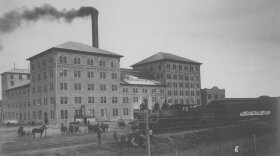Hello, I’m Dennis Garcia and I’m from Garden City, Kansas. For most Americans in the last century their first encounter with a person of different heritage occurred in the schools.
That was the case in my family. My grandfather, Jose, was working for the Santa Fe Railroad in 1920 when the Santa Fe shipped him and his family from El Paso, Texas to Southwest Kansas.
In 1928, Jose bought a small house in Garden City’s Mexican Barrio along the Santa Fe’s tracks. There he and my grandmother raised six sons.
Garden City’s schools were not segregated at the time, so it was inevitable that Jose and Rosa’s sons and future grandchildren would encounter and interact with children of the white majority at the schools. Largely because the family became migrant farm workers and laborers during the Great Depression and Dust Bowl, the boys did not complete their schooling beyond the eighth grade. The same was true for many kids raised on farms on the high plains, education was second to work and putting food on the table. But as parents, these Great Depression survivors insisted that their children graduate with high school diplomas.
By the late 1950s Garden City’s high school football team included the names Mendoza, Ortiz, Garcia, Escalada, and Sandoval. After the Friday night games students gathered at the Garden City Recreation Center for dances. There were attempts to keep white students, many of them from German, Irish and English ancestry, from dancing with Mexican and black students. But over time the Center accepted that efforts to prevent the students from interacting were futile. The students insisted on dancing together and enjoying their Richie Cunningham Happy Days moments.
My first high school date occurred in June 1966. Jean was of Italian ancestry and lived in Wichita, Kansas. She came to Garden City with a Mexican girl friend to attend the wedding of her friend’s cousin. I met Jean a week before the wedding and we agreed to meet at the wedding dance. I was aware of the ghosts of the Recreation Center and racial tension still in Garden City. And I knew that some of the wedding guests might raise an eyebrow at a couple of mixed heritage. But I chose to pursue my friendship with Jean.
I was anxious while I awaited Jean’s arrival at the small dance hall, and thrilled when she entered. She was thin, dark haired and slightly taller than me. Early on I suffered the typical awkward moments of a high school date. One of those moments began when the local band began playing traditional Mexican oompa-oompa polkas. I knew the steps, but she did not. So, we decided to go on to the dance floor when there were enough dancers to hide our efforts. We looked down at our feet and without any grace tried to move with the flow of the other dancers. But it was a choppy, stop and go result. Disappointed at our plan’s failure, we left the floor.
But a short while later the band began playing La Bamba, a popular rock and roll tune. We immediately made our way on to the floor and began to dance at each other’s side. With simple one-two-three, one-two-three steps we circled the dance floor. La Bamba’s melody and African influenced rhythms smoothed our steps as we made our way. With La Bamba, our dancing became a celebration of joy and spirit, as it has been for the people of Veracruz, Mexico for nearly three centuries, a fact unknown to Mexicans and non-Mexicans alike. Imagine that, a three hundred year old Top 40 hit!
For the rest of the dance we were at ease, enjoyed each other’s company, and ended the evening with a kiss. La Bamba swept away the awkwardness and uncertainty between two teenagers caused by differences in color and heritage and replaced them with a lasting memory.
Thanks for sharing this memory I’m Dennis Garcia, author of Marine, Public Servant, Kansan: The Life of Ernest Garcia. It’s available from your favorite online retailer and through the University Press of Kansas. My thanks to High Plains Public Radio.







